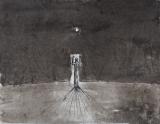Heaven and Earth - Miklós Borsos and the Bible
Rómer Flóris Art and Historical Museum - Esterházy Palace

Started last November, the four-exhibition series with which the Debrecen Reformed Theological University and the Kovács Gábor Art Foundation (KOGART) salutes the 500th anniversary of the Reformation, continues with a new event, opening on 23 April in the Esterházy Palace, Győr. This display features such work by Miklós Borsos that was inspired by the Bible.
In cooperation with the Debrecen Reformed Theological University, the Kovács Gábor Art Foundation celebrates the momentous anniversary with an extensive series of exhibitions. The four displays present works of art that were inspired by the Bible and that confront us with key questions of life.
Miklós Borsos is one of the most versatile figures of 20th-century Hungarian art, who left behind lasting works in all forms of visual art. Best-known as a sculptor, the artist did not obtain his knowledge in a formal manner, at schools, but emulated the centuries-old practice of studying the working methods and artistic solutions of old masters.
The Bible was an essential source for a substantial part of Borsos’s oeuvre, with the Old and New Testament providing him with many of his themes. He did not make a distinct series of these works, which are only loosely related; nor are their approaches and motifs always markedly different from those compositions whose inspiration was antique, musical or nature-related.
His biblical images do not narrate; when he concentrated on the human aspect of these stories, he explored such key experiences and questions of life on earth as suffering, hope, struggle, faith, creation, solitude and compassion. And the draughtsman is more than the chronicler of all this: he is also a participant, as Borsos’s hidden self-portrait can be identified as the recurring male figure of the paper-based works. In other words, he set out from his own struggles and encounters, reckoned with them, and attempted to convey something of the experience—the personal aspect is integral to these works. As Borsos put it, “from the history of the human soul I unearthed my own experiences, in relation to my own threads of thought.”
Those images of Borsos that have religious subjects, or rather, bring into motion religious meanings, tend to represent not specific stories but human situations and gestures, which make their message familiar, easy to “translate.” Said the artist of his relationship to the Bible: “I was first interested in the unspeakably bizarre, dramatic, horrific part of the Old Testament, the stories of the prophets, so I made drawings for these... Then in the New Testament I was taken by the clarity, the simplicity of the Sermon on the Mount... During the tragedy of our family, my sister’s illness, it was also there that I sought some manner of calm for my nerves, and I think I did find it.”
The exhibition is presented with support from Hungary’s Ministry of Human Resources, and was jointly organized by the Kovács Gábor Art Foundation, the Debrecen Reformed Theological University, and the Rómer Flóris Museum of Art and History. It is on view until 11 June, 2017.
The display was curated by Richárd Kosinsky, art historian of the Kovács Gábor Art Foundation.
The exhibition in Győr will be followed by one in Cluj-Napoca, and one in Budapest. The last display dedicated to the Reformation will open on 7 October, 2017, in the Castle Garden Bazaar; it will bring the anniversary to its climax both with its theme and concept.
The Facebook page of the exhibition series: https://www.facebook.com/reformacio500kiallitas/
Rómer Flóris Museum of Art and History – Esterházy Palace, Győr | 17 Király utca
Opening hours: Tuesday – Sunday, 10 am – 6 pm
